Fundamentals of Circuits I: Current Models, Batteries & Bulbs
Fundamentals of Circuits I: Current Models, Batteries & Bulbs
Fundamentals of Circuits I: Current Models, Batteries & Bulbs
Create successful ePaper yourself
Turn your PDF publications into a flip-book with our unique Google optimized e-Paper software.
<strong>Fundamentals</strong> <strong>of</strong> <strong>Circuits</strong> I: <strong>Current</strong> <strong>Models</strong>, <strong>Batteries</strong> & <strong>Bulbs</strong> v 0.1<br />
Investigation 2:<br />
Using electric circuit symbols<br />
Representing electric circuits by drawings, like Fig. 5, can be very tedious. It can also be<br />
confusing for circuits that have many components. To make it easier to design electric circuits<br />
standard symbols have been established to represent the various components that make up an<br />
electric circuit. A few <strong>of</strong> these are shown below. More will be introduced in future experiments.<br />
V = 1.5V<br />
S<br />
+ −<br />
Battery<br />
Switch<br />
R<br />
I<br />
Bulb<br />
Figure 9: Circuit Elements<br />
Wire<br />
Activity 2.1: Drawing circuits<br />
Question 2.1 Draw the circuit represented by Fig. 5 using the symbols above.<br />
Question 2.2 On the battery symbol, which line represents the positive terminal-the long one<br />
or the short one (Note: you should try to remember this convention. There are many situations<br />
in which it is important to distinguish the positive and negative terminals.)<br />
PHYS-204: Physics II Laboratory 12
















